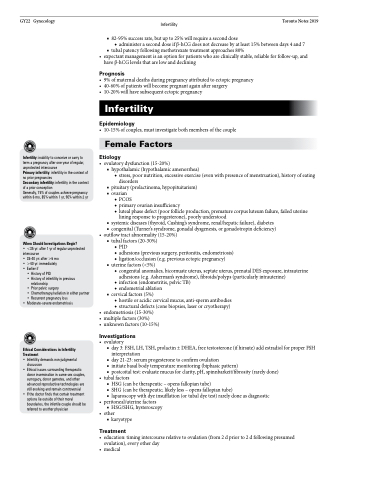Page 508 - TNFlipTest
P. 508
GY22 Gynecology
Infertility Toronto Notes 2019
■ 82-95% success rate, but up to 25% will require a second dose
◆ administer a second dose if β-hCG does not decrease by at least 15% between days 4 and 7
■ tubal patency following methotrexate treatment approaches 80%
• expectantmanagementisanoptionforpatientswhoareclinicallystable,reliableforfollow-up,and
have β-hCG levels that are low and declining
Prognosis
• 9%ofmaternaldeathsduringpregnancyattributedtoectopicpregnancy • 40-60%ofpatientswillbecomepregnantagainaftersurgery
• 10-20%willhavesubsequentectopicpregnancy
Infertility
Epidemiology
• 10-15%ofcouples,mustinvestigatebothmembersofthecouple
Female Factors
Etiology
• ovulatorydysfunction(15-20%)
■ hypothalamic (hypothalamic amenorrhea)
◆ stress, poor nutrition, excessive exercise (even with presence of menstruation), history of eating disorders
■ pituitary (prolactinoma, hypopituitarism) ■ ovarian
◆ PCOS
◆ primary ovarian insufficiency
◆ luteal phase defect (poor follicle production, premature corpus luteum failure, failed uterine
lining response to progesterone), poorly understood
■ systemic diseases (thyroid, Cushing’s syndrome, renal/hepatic failure), diabetes ■ congenital (Turner’s syndrome, gonadal dysgenesis, or gonadotropin deficiency)
• outflowtractabnormality(15-20%) ■ tubal factors (20-30%)
◆ PID
◆ adhesions (previous surgery, peritonitis, endometriosis) ◆ ligation/occlusion (e.g. previous ectopic pregnancy)
■ uterine factors (<5%)
◆ congenital anomalies, bicornuate uterus, septate uterus, prenatal DES exposure, intrauterine
adhesions (e.g. Asherman’s syndrome), fibroids/polyps (particularly intrauterine) ◆ infection (endometritis, pelvic TB)
◆ endometrial ablation
■ cervical factors (5%)
◆ hostile or acidic cervical mucus, anti-sperm antibodies ◆ structural defects (cone biopsies, laser or cryotherapy)
• endometriosis(15-30%)
• multiplefactors(30%)
• unknownfactors(10-15%)
Investigations
• ovulatory
■ day 3: FSH, LH, TSH, prolactin ± DHEA, free testosterone (if hirsute) add estradiol for proper FSH
interpretation
■ day 21-23: serum progesterone to confirm ovulation
■ initiate basal body temperature monitoring (biphasic pattern)
■ postcoital test: evaluate mucus for clarity, pH, spinnbarkeit/fibrosity (rarely done)
• tubalfactors
■ HSG (can be therapeutic – opens fallopian tube)
■ SHG (can be therapeutic; likely less – opens fallopian tube)
■ laparoscopy with dye insufflation (or tubal dye test) rarely done as diagnostic
• peritoneal/uterinefactors
■ HSG/SHG, hysteroscopy
• other
■ karyotype
Treatment
• education:timingintercourserelativetoovulation(from2dpriorto2dfollowingpresumed ovulation), every other day
• medical
Infertility: inability to conceive or carry to term a pregnancy after one year of regular, unprotected intercourse
Primary infertility: infertility in the context of no prior pregnancies
Secondary infertility: infertility in the context of a prior conception
Generally, 75% of couples achieve pregnancy within 6 mo, 85% within 1 yr, 90% within 2 yr
When Should Investigations Begin?
• <35 yr: after 1 yr of regular unprotected intercourse
• 35-40 yr: after >6 mo
• >40 yr: immediately
• Earlier if
• History of PID
• History of infertility in previous
relationship
• Prior pelvic surgery
• Chemotherapy/radiation in either partner
• Recurrent pregnancy loss
• Moderate-severe endometriosis
Ethical Considerations in Infertility Treatment
• Infertility demands non-judgmental
discussion
• Ethical issues surrounding therapeutic
donor insemination in same sex couples, surrogacy, donor gametes, and other advanced reproductive technologies are still evolving and remain controversial
• If the doctor finds that certain treatment options lie outside of their moral boundaries, the infertile couple should be referred to another physician


